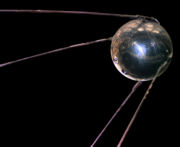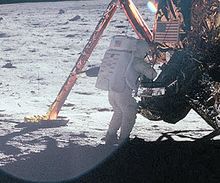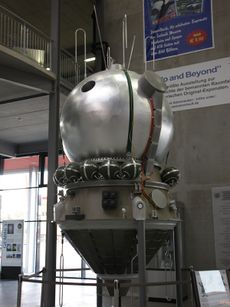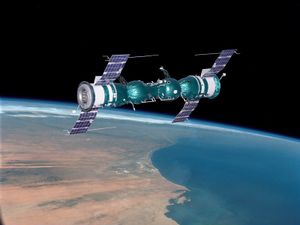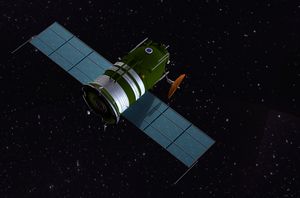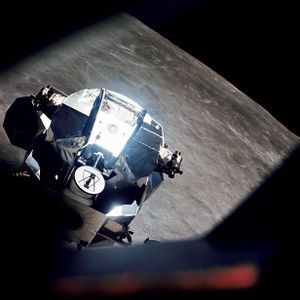سباق الفضاء
سباق الفضاء هو سباق بدأ أساساً بين الاتحاد السوفييتي و الولايات المتحدة الأمريكية كجزء من الحرب الباردة، محوره التسابق علي أخذ أكبر مساحة من الفضاء عن طريق الأقمار الصناعية و مركبات الفضاء المأهولة و غير المأهولة، كان الأمر إظهار للقدرة و التقنية لكلتا الدولتين في مجال غزو الفضاء.
بدأ هذا السباق عندما أطلق الاتحاد السوفييتي أول قمر اصطناعي في العالم هو سبوتنك-1 في 4 أكتوبر 1957، ثم أكد الاتحاد السوفيتي سبقه عندما أطلق قمره الاصطناعي الثاني سبوتنك-2 في 3 نوفمبر 1957.
Soviet rocket development

Cold War missile race
William E. Burrows, This New Ocean, "The Other World Series", p. 147
Competition begins
US reaction

Uncrewed lunar probes
First human in space
The radio communication between the launch control room and Gagarin included the following dialogue at the moment of rocket launch:
Korolev: "Preliminary stage..... intermediate..... main..... lift off! We wish you a good flight. Everything is all right." Gagarin: "Поехали!" (Poyekhali! - Let's go!).[1]
Gagarin's informal poyekhali! became a historical phrase in the Eastern Bloc, used to refer to the beginning of the human space flight era.[2][3]
First American in space
Completion of Vostok and Mercury programs
Mercury
Vostok
Kennedy proposes a joint US-USSR program
After a first US-USSR Dryden-Blagonravov agreement and cooperation on the Echo II balloon satellite in 1962,[4] President Kennedy proposed on September 20, 1963, in a speech before the United Nations General Assembly, that the United States and the Soviet Union join forces in an effort to reach the Moon. Kennedy thus changed his mind regarding the desirability of the space race, preferring instead to ease tensions with the Soviet Union by cooperating on projects such as a joint lunar landing.[5] Soviet Premier Nikita Khrushchev initially rejected Kennedy's proposal.[6] However, on October 2, 1997, it was reported that Khrushchev's son Sergei claimed Khrushchev was poised to accept Kennedy's proposal at the time of Kennedy's assassination on November 22, 1963. During the next few weeks he reportedly concluded that both nations might realize cost benefits and technological gains from a joint venture, and decided to accept Kennedy's offer based on a measure of rapport during their years as leaders of the world's two superpowers, but changed his mind and dropped the idea since he did not have the same trust for Kennedy's successor, Lyndon Johnson.[6]
As President, Johnson steadfastly pursued the Gemini and Apollo programs, promoting them as Kennedy's legacy to the American public. One week after Kennedy's death, he issued an executive order renaming the Cape Canaveral and Apollo launch facilities after Kennedy.[بحاجة لمصدر]
جمناي و ڤوسخود
برنامج ڤوسخود
مشروع جمناي
Soviet crewed Moon programs
Korolev's design bureau produced two prospectuses for circumlunar spaceflight (March 1962 and May 1963), the main spacecraft for which were early versions of his Soyuz design. Soviet Communist Party Central Committee Command 655-268 officially established two secret, competing crewed programs for circumlunar flights and lunar landings, on August 3, 1964. The circumlunar flights were planned to occur in 1967, and the landings to start in 1968.[7]
Outer space treaty
The US and USSR began discussions on the peaceful uses of space as early as 1958, presenting issues for debate to the United Nations,[8][9][10] which created a Committee on the Peaceful Uses of Outer Space in 1959.[11]
This treaty:
- bars party States from placing weapons of mass destruction in Earth orbit, on the Moon, or any other celestial body;
- exclusively limits the use of the Moon and other celestial bodies to peaceful purposes, and expressly prohibits their use for testing weapons of any kind, conducting military maneuvers, or establishing military bases, installations, and fortifications;
- declares that the exploration of outer space shall be done to benefit all countries and shall be free for exploration and use by all the States;
- explicitly forbids any government from claiming a celestial resource such as the Moon or a planet, claiming that they are the common heritage of mankind, "not subject to national appropriation by claim of sovereignty, by means of use or occupation, or by any other means". However, the State that launches a space object retains jurisdiction and control over that object;
- holds any State liable for damages caused by their space object;
- declares that "the activities of non-governmental entities in outer space, including the Moon and other celestial bodies, shall require authorization and continuing supervision by the appropriate State Party to the Treaty", and "States Parties shall bear international responsibility for national space activities whether carried out by governmental or non-governmental entities"; and
- "A State Party to the Treaty which has reason to believe that an activity or experiment planned by another State Party in outer space, including the Moon and other celestial bodies, would cause potentially harmful interference with activities in the peaceful exploration and use of outer space, including the Moon and other celestial bodies, may request consultation concerning the activity or experiment."
The treaty remains in force, signed by 107 member states. – اعتبارا من July 2017[تحديث]
الكوارث تضرب الطرفين
In 1967, both nations faced serious challenges that brought their programs to temporary halts. Both had been rushing at full-speed toward the first piloted flights of Apollo and Soyuz, without paying due diligence to growing design and manufacturing problems. The results proved fatal to both pioneering crews.[بحاجة لمصدر]
قـُدُماً إلى القمر
أپولو 11
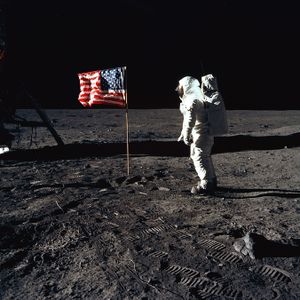
التنافس يخبو
NASA had ambitious follow-on human spaceflight plans as it reached its lunar goal, but soon discovered it had expended most of its political capital to do so.[12]
ساليوت وسكايلاب
المشروع التجريبي أپولو-سويوز

الذكرى
ارتياد البشر للفضاء بعد أپولو
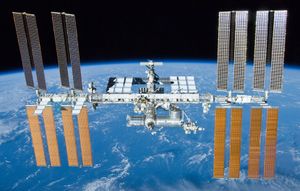
See also
- Billionaire space race
- Cold War playground equipment
- Comparison of Asian national space programs—a so-called "Asian space race"
- History of spaceflight
- List of space exploration milestones, 1957–1969
- Moon Landing
- Moon Shot
- Space advocacy
- Space exploration
- Space policy
- Space propaganda
- Spaceflight records
- Timeline of Solar System exploration
- Timeline of space exploration
- Timeline of the Space Race
- Woods Hole Conference
- Mars race
Notes
- ^ Hall and Shayler, p.150
- ^ Душенко, Константин (2014). Большой словарь цитат и крылатых выражений (in Russian). Litres. ISBN 978-5-699-40115-4.
{{cite book}}: CS1 maint: unrecognized language (link) - ^ Pervushin (2011), 6.2 Он сказал «Поехали!»
- ^ U.S.-Soviet Cooperation in Space. US Congress, Office of Technology Assessment. July 1985. pp. 80–81. Archived from the original. You must specify the date the archive was made using the
|archivedate=parameter. https://www.princeton.edu/~ota/disk2/1985/8533/8533.PDF. Retrieved on 13 June 2018. - ^ Stone, Oliver and Peter Kuznick, "The Untold History of the United States" (Gallery Books, 2012), page 320
- ^ أ ب Sietzen, Frank (2 October 1997). "Soviets Planned to Accept JFK's Joint Lunar Mission Offer". "SpaceCast News Service" Washington DC -. Retrieved 1 February 2011.
- ^ Portree, Part 1 - 1.2 Historical Overview
- ^ inesap.org Archived مارس 18, 2008 at the Wayback Machine Peaceful Uses of Outer Space and International Law.
- ^ Google books Nuclear Weapons and Contemporary International Law N.Singh, E. WcWhinney (p.289)
- ^ UN website UN Resolution 1348 (XIII).
- ^ "United Nations Committee on the Peaceful Uses of Outer Space". United Nations Office for Outer Space Affairs.
- ^ Hepplewhite, p. 186
References
- Bilstein, Roger E. (1996). Stages to Saturn: A Technological History of the Apollo/Saturn Launch Vehicles. Washington: Scientific and Technical Information Branch, National Aeronautics and Space Administration. ISBN 0-16-048909-1.
- Burgess, Colin; Kate Doolan; Bert Vis (2003). Fallen Astronauts: Heroes Who Died Reaching for the Moon. Lincoln: University of Nebraska Press. ISBN 0-8032-6212-4.
- Brzezinski, Matthew (2007). Red Moon Rising: Sputnik and the Hidden Rivalries that Ingnited the Space Race. New York: Times Books, Henry Holt and Company. ISBN 978-0-8050-8147-3.
- Burrows, William E. (1998). This New Ocean: The Story of the First Space Age. New York: Random House. ISBN 978-0-679-44521-0. قالب:ASIN.
- Cadbury, Deborah (2006). Space Race: The Epic Battle Between America and the Soviet Union for Dominance of Space. New York: Harper Collins Publishers. ISBN 978-0-06-084553-7.
- Chaikin, Andrew (1994). A Man on the Moon: The Triumphant Story of the Apollo Space Program. New York: Penguin Books. ISBN 0140272011.
- Cornwell, John (2003). Hitler's Scientists: Science, War, and the Devil's Pact. New York: Viking Press. ISBN 0-670-03075-9.
- Dallek, Robert (2003). An Unfinished Life: John F. Kennedy, 1917–1963. Boston: Little, Brown and Company. ISBN 0-316-17238-3.
- David, Leonard. Moon Rush (Simon and Schuster, 2019).
- Gainor, Chris (2001). Arrows to the Moon: Avro's Engineers and the Space Race. Burlington, Ontario: Apogee Books. ISBN 1-896522-83-1.
{{cite book}}: CS1 maint: url-status (link) - Gatland, Kenneth (1976). Manned Spacecraft, Second Revision. New York, NY, USA: Macmillan Publishing Co., Inc. pp. 100–101. ISBN 0-02-542820-9.
- Hall, Rex; David J. Shayler (2001). The Rocket Men: Vostok & Voskhod, The First Soviet Manned Spaceflights. New York: Springer–Praxis Books. ISBN 1-85233-391-X.
- Hall, Rex; David J. Shayler (2003). Soyuz: A Universal Spacecraft. New York: Springer–Praxis Books. ISBN 1-85233-657-9.
- Hardesty, Von; Gene Eisman (2007). Epic Rivalry: The Inside Story of the Soviet and American Space Race. Foreword by Sergei Khrushchev. Washington: National Geographic Society. ISBN 978-1-4262-0119-6.
- Harford, James J. (1997). Korolev: How One Man Masterminded the Soviet Drive to Beat America to the Moon (1 ed.). New York: John Wiley & Sons. ISBN 0-471-14853-9.
- Hepplewhite, T.A. (1999). The Space Shuttle Decision: NASA's Search for a Reusable Space Vehicle. Washington, DC: NASA.
- Jones, Eric M. (1 January 2010). "Apollo 11 Lunar Surface Journal". Apollo Lunar Surface Journal. Internet. Retrieved 15 August 2010.
- Kraft, Chris; James Schefter (2001). Flight: My Life in Mission Control. New York: Dutton. ISBN 0-525-94571-7.
- Murray, Charles; Catherine Bly Cox (1990). Apollo: The Race to the Moon. New York: Touchstone (Simon & Schuster). ISBN 0-671-70625-X.
The link is to the 2004 edition, pages differ, but content the same.
- Parry, Dan (2009). Moonshot: The Inside Story of Mankind's Greatest Adventure. Chatham, United Kingdom: Ebury Press. ISBN 978-0-09-192837-7.
- Pekkanen, Saadia M. "Governing the New Space Race." AJIL Unbound 113 (2019): 92-97. online, role of international law.
- Polmar, Norman; Timothy M. Laur (1990). Strategic Air Command: People, Aircraft, and Missiles (2 ed.). Baltimore: Nautical and Publishing Company of America. ISBN 0-933852-77-0.
- Poole, Robert (2008). Earthrise: How Man First Saw the Earth. New Haven, Connecticut: Yale University. ISBN 978-0-300-13766-8.
- Portree, David S.F. (March 1995), Part 1: Soyuz, "Mir Hardware Heritage", Reference Publication, NASA Reference Publication 1357 (Houston TX: NASA) 95: 23249, Bibcode: 1995STIN...9523249P
- Schefter, James (1999). The Race: The uncensored story of how America beat Russia to the Moon. New York: Doubleday. ISBN 0-385-49253-7.
- Schmitz, David F. (1999). "Cold War (1945–91): Causes". In Whiteclay Chambers, John (ed.). The Oxford Companion to American Military History. Oxford University Press. ISBN 0-19-507198-0.
- Seamans, Robert C., Jr. (1967). "Findings, Determinations And Recommendations". Report of Apollo 204 Review Board. NASA History Office.
{{cite book}}: CS1 maint: multiple names: authors list (link) - Siddiqi, Asif A. (2003). Sputnik and the Soviet Space Challenge. Gainesville: University Press of Florida. ISBN 0-8130-2627-X.
- Siddiqi, Asif A. (2003). The Soviet Space Race with Apollo. Gainesville: University Press of Florida. ISBN 0-8130-2628-8.
- Stocker, Jeremy (2004). Britain and Ballistic Missile Defence, 1942–2002. London: Frank Case. pp. 12–24. ISBN 0-7146-5696-8.
- Turnhill, Reginald (2004). The Moonlandings: An Eyewitness Account. New York: Cambridge University Press. ISBN 0-521-81595-9.
- Первушин, Антон (2011). 108 минут, изменившие мир. Эксмо. ISBN 978-5-699-48001-2. (Anton Pervushin. 108 minutes which changed the world; in Russian)
External links
- Scanned letter from Wernher Von Braun to Vice President Johnson
- "America's Space Program: Exploring a New Frontier", a National Park Service Teaching with Historic Places (TwHP) lesson plan
- Why Did the USSR Lose the Moon Race? from Pravda, 2002-12-03
- Space Race Exhibition at the Smithsonian National Air and Space Museum
- TheSpaceRace.com – Mercury, Gemini, and Apollo space programs
- Timeline of the Space Race to the Moon 1960 – 1969
- Shadows of the Soviet Space Age, Paul Lucas
- Chronology:Moon Race at russianspaceweb.com
- John F. Kennedy Moon Speech at Rice Stadium and Apollo 11 Mission Video at YouTube
- Short description is different from Wikidata
- Articles with hatnote templates targeting a nonexistent page
- Articles with hAudio microformats
- Articles containing روسية-language text
- Articles with unsourced statements from July 2019
- مقالات فيها عبارات متقادمة منذ July 2017
- جميع المقالات التي فيها عبارات متقادمة
- CS1 maint: url-status
- مقالات ناطقة
- الحرب الباردة
- History of science and technology in the United States
- العلوم والتكنولوجيا في الاتحاد السوڤيتي
- Soviet Union–United States relations
- Presidency of John F. Kennedy
- Space policy
- Presidency of Lyndon B. Johnson
- Presidency of Dwight D. Eisenhower
- Presidency of Richard Nixon
- Presidency of Gerald Ford
- تنافس جيوسياسي
- Technological races
- Operation Paperclip
- استكشاف الفضاء
